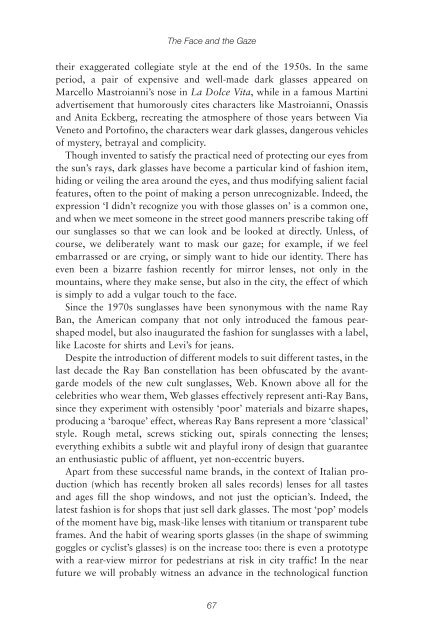You also want an ePaper? Increase the reach of your titles
YUMPU automatically turns print PDFs into web optimized ePapers that Google loves.
<strong>The</strong> Face and the Gaze<br />
their exaggerated collegiate style at the end of the 1950s. In the same<br />
period, a pair of expensive and well-made dark glasses appeared on<br />
Marcello Mastroianni’s nose in La Dolce Vita, while in a famous Martini<br />
advertisement that humorously cites characters like Mastroianni, Onassis<br />
and Anita Eckberg, recreating the atmosphere of those years between Via<br />
Veneto and Portofino, the characters wear dark glasses, dangerous vehicles<br />
of mystery, betrayal and complicity.<br />
Though invented to satisfy the practical need of protecting our eyes from<br />
the sun’s rays, dark glasses have become a particular kind of fashion item,<br />
hiding or veiling the area around the eyes, and thus modifying salient facial<br />
features, often to the point of making a person unrecognizable. Indeed, the<br />
expression ‘I didn’t recognize you with those glasses on’ is a common one,<br />
and when we meet someone in the street good manners prescribe taking off<br />
our sunglasses so that we can look and be looked at directly. Unless, of<br />
course, we deliberately want to mask our gaze; for example, if we feel<br />
embarrassed or are crying, or simply want to hide our identity. <strong>The</strong>re has<br />
even been a bizarre fashion recently for mirror lenses, not only in the<br />
mountains, where they make sense, but also in the city, the effect of which<br />
is simply to add a vulgar touch to the face.<br />
Since the 1970s sunglasses have been synonymous with the name Ray<br />
Ban, the American company that not only introduced the famous pearshaped<br />
model, but also inaugurated the fashion for sunglasses with a label,<br />
like Lacoste for shirts and Levi’s for jeans.<br />
Despite the introduction of different models to suit different tastes, in the<br />
last decade the Ray Ban constellation has been obfuscated by the avantgarde<br />
models of the new cult sunglasses, Web. Known above all for the<br />
celebrities who wear them, Web glasses effectively represent anti-Ray Bans,<br />
since they experiment with ostensibly ‘poor’ materials and bizarre shapes,<br />
producing a ‘baroque’ effect, whereas Ray Bans represent a more ‘classical’<br />
style. Rough metal, screws sticking out, spirals connecting the lenses;<br />
everything exhibits a subtle wit and playful irony of design that guarantee<br />
an enthusiastic public of affluent, yet non-eccentric buyers.<br />
Apart from these successful name brands, in the context of Italian production<br />
(which has recently broken all sales records) lenses for all tastes<br />
and ages fill the shop windows, and not just the optician’s. Indeed, the<br />
latest fashion is for shops that just sell dark glasses. <strong>The</strong> most ‘pop’ models<br />
of the moment have big, mask-like lenses with titanium or transparent tube<br />
frames. And the habit of wearing sports glasses (in the shape of swimming<br />
goggles or cyclist’s glasses) is on the increase too: there is even a prototype<br />
with a rear-view mirror for pedestrians at risk in city traffic! In the near<br />
future we will probably witness an advance in the technological function<br />
67

















